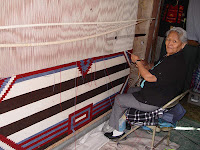 |
First Phase Cheif Blanket on the
Antiques Roadshow in Tuscon, AZ in 2002 |
An abridged history lesson:
 |
| Cheif Blanket as it Should Be Worn |
This “First Phase” weaving period lasted from approximately 1750 until the internment of 8000 Navajo people at Fort Sumner in 1864. The 300 mile “Long Walk of the Navajo” killed hundreds while on the journey and even more died in the prison camps. When they were finally released to their homelands four years later, the Navajo people discovered that their homes had been razed, their fields had been burned and their sheep had been killed.
 |
| Weaving a Third Phase Blanket in a Modern Era |
By about 1850, the Navajo weavers, aided by the westward trains and a more open trade philosophy, began a “Second Phase” of blanket weaving and then an overlapping “Third Phase.” These later phases are differentiated from the First Phase by color, design motifs, the use of synthetic dyes, and wool quality. When large trading posts began to dot the region around 1890, the weavers segued from blankets to rugs. Tourists would pay more money for an intricately patterned, quality rug. Now there are many different types of Navajo rugs and they are typically valued at more money per square foot than even the finest Persian rugs.
The different Phases at a glance:
2nd Phase:
*slightly more complicated striped pattern
*addition of red bars in the center and corners
*slightly more complicated striped pattern
*addition of red bars in the center and corners
 3rd Phase:
3rd Phase: *complex wavy lines hidden in the striped pattern
*addition of serrated diamonds and triangles in the center and corners
If you would like more information on my Trash or Treasure Traveling Rug Show or if you have any questions for me to answer, I can be contacted by email: Lynn@rugadvocate.com


Awesome history lesson about Navajo Rugs. it is a shame that it is a dying art form.
ReplyDeleteNever wash a chiefs blanket without being very careful. Those stains may be warpaint and can increase the value at auction. If you get one of these in and you might check with an expert first. Also if there are moths or bugs freeze rather than treat with chemicals. A blanket can sell for over 1 million dollars so special care is in order until you prove otherwise.
ReplyDeleteVery, very interesting history! Thank you Lynn very much for doing the research and sharing this piece of history with us! You write an EXCELLENT blog! That video was really neat, it was nice to see that gentleman get that great news about this blanket. I look forward to your next blog Lynn! :)
ReplyDeleteIt is too bad Youtube got rid of the video :(
ReplyDeleteThat's something I wouldn't want to even attempt to clean! They definitely are beautiful though.
ReplyDeleteSuch a nice blog... Thanks for sharing..
ReplyDeleteFor further details go to Ruckstuhl or click on the given link in this line.
We found your blog was much handy to me! If u keep up the good job I’ll come back at your website.
ReplyDeleteCleaning Oriental Rugs
Carpet Cow has been one of the largest Carpet and Rug Dealers in the Tri-State area. Find wide selection of Rug. We are dedicated to providing first quality merchandise and service to our customers. In fact, most of our customers come to us by word of mouth.
ReplyDeleteThank you for the history lesson. I had been wondering why they said it was a Ute blanket but a fine example of Navajo weaving. Didn't make sense to me.
ReplyDelete